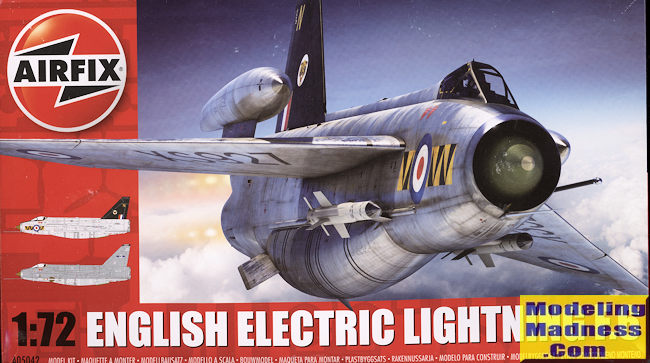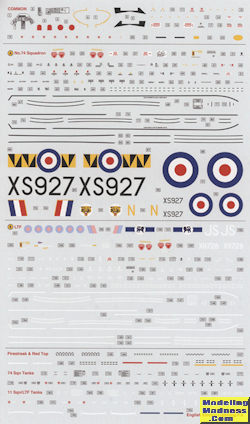
| KIT #: | A05042 |
| PRICE: | $25.00 SRP |
| DECALS: | Two options |
| REVIEWER: | Scott Van Aken |
| NOTES: |

| HISTORY |
The last supersonic single seat fighter developed by the British and put into unit service was the BAC/E.E. Lightning. Though not built in large numbers, the type has etched itself into the consciousness of aviation fans all throughout the UK. A maintenance nightmare according to those who worked on it, the aircraft was, nevertheless, quite capable and extremely fast. In fact, its speed was a major plus for an interceptor in the UK when the warning time was minimal. It was also quite fuel thirsty and was often seen with its somewhat unique over-wing fuel tanks. This odd arrangement has been used on a few other aircraft for weapons, but to my knowledge, no other aircraft has routinely carried them in this fashion. Though the type was withdrawn from service in the late 1980s, several still operate in the UK doing fast taxy demonstrations and I believe at least one is airworthy in South Africa. The British aviation authorities will not allow private flying of the Lightning due to the ease at which the control surface hydraulic lines could easily be switched by accident and the lack of manual back-up. Then there is the problem with general maintenance, but the flight control deal that has kept them grounded.
The F.2A and F.6 are upgrades of the standard F.1A/F2 variant. The major differences are the enlarged belly tank that with the F.6 variant, includes the cannon armament, removing that from the nose where it was in earlier versions, and a larger, square-tipped fin. The F.2A still kept the upper nose guns and did not normally have them in the belly pack. Also added to this version were the ability to carry over-wing fuel tanks. These aircraft operated the Firestreak and Redtop missiles as their primary armament.The F.6 only had the guns in the forward tank and carried Red Top missiles. F.6s were replaced by either Phantom or Tornado F.3 aircraft, the last ones in service being retired in 1988.
| THE KIT |
Moving up to a Series 5 kit from the previous F.2's Series 4, one has to wonder what was added to allow this version to be $7.50 more expensive. Comparing the spures with the previously previewed kit, it seems your $7.50 will get you one additional sprue. That sprue contains the over wing fuel tanks, two Red Top missiles and rails, longer cable ducts, rails, along with the gun inserts for the ventral fuel tank. I found it interesting that the missiles have half of the fins molded on one body half with the others being added once the missile body is together. Those wanting better missiles would be advised to check out the nice resin ones from BarracudaCast. The rest of the kit is exactly the same as the F.2A kit.
Molding is quite good and while some may still think the engravings are too large (and they are compared to some others), they look fine to me and I'm sure that most will be pleased with what they see. Based on their other more recent kits, the engineering should be first rate. The cockpit (which is quite small) has a bang seat and control stick, using decals for instruments and consoles. The seat is pretty generic so those not wanting to use the pilot might want to look for aftermarket. I will be difficult not to make comparisons with the Trumpeter kit as both model companies have designed their Lightning kits in a similar manner. This one has a full intake trunking with a blanking plate that has an engine compressor face in the lower section. The intake itself incorporates the nose gear well and is where you stick the weight, after which you install the radome. Kit instructions say 4 grams should cover it. Add more.
Long burner cans are provided with an exhaust compressor blanking plate on one end and the burner petals along with the exhaust plate on the other. These are then sandwiched in between the fuselage halves. The front part of the belly tank is separate and contains the two part forward section without the guns. Wings are in upper and lower sections and one must open holes for the refueling probe. Separate flaps and provided which is a bit of a waste as they were normally in the neutral position except during landing and maintenance.
Back in the front are inserts for either the nose guns
or blanking plates. Apparently the F.2A could have lower guns, though it seems
that in later years these were removed. As with every 1/72 Lighting I've seen or
built, the nose wheel is incorporated with the nose gear. Main gear is nicely
done and the kit offers either multiple piece main gear doors for gear down or a
single piece for gear up. The kit also provides open or closed speed brakes, but
again, these were normally closed. The proper Firestreak missiles are included
though the clear sprue also has the rounded seeker nose for the Red Tops. The
canopy can be displayed open or closed. A nice addition is the inclusion of an
intake cover. Those who are anal about Lightnings know that the cable duct on
the left side of the fuselage was different lengths for different planes. This
one has an insert for the proper short length that was fitted to the F.2A.
seeker nose for the Red Tops. The
canopy can be displayed open or closed. A nice addition is the inclusion of an
intake cover. Those who are anal about Lightnings know that the cable duct on
the left side of the fuselage was different lengths for different planes. This
one has an insert for the proper short length that was fitted to the F.2A.
Instructions are typical Airfix in that only Humbrol paint numbers are provided for the construction sequences. When it comes to the overall painting, actual colors are given. New to me is that some subassemblies are shown in color in the instructions. I guess it helps. Decals are nicely done and provide two markings; one for box art plane from 74 squadron which has to be a real favorite in the UK as so many kit decals have this as an option. This is in the older bare metal scheme so is quite colorful. The other is in the scheme worn at the end of their service by many Lightnings. In this case is is the Dark Sea Grey over Medium Sea Grey scheme with 11 squadron/LTFL (Lightning Training Flight) from 1988. The decals also include both the black and white stencil and wing walk markings appropriate for whatever scheme you choose. The decals are nicely done and if you want other options, they are out there.
| CONCLUSIONS |
As often happens with new kits that replicate kits already on the market one has to ask if they are really needed. Well, they are not needed, but it is quite nice to have options. The only other kit of similar quality is that by Trumpeter. This one is $7.00 dollars less expensive (retail) and so is probably the one many will choose. Undoubtedly the Airfix kit is much less expensive in the UK where most of these kits will undoubtedly be sold. For those of us who like the Lightning, it is nice to have options and I need to say that even the ancient Hasegawa kit makes into a very nice model if one needs something to just build, paint and put on the display shelf.
January 2017
Copyright ModelingMadness.com. All rights reserved.
Thanks to your editor for the preview kit.
If you would like your product reviewed fairly and fairly quickly, please contact the editor or see other details in the Note to Contributors.